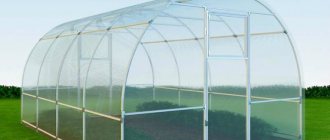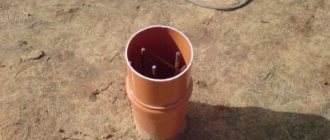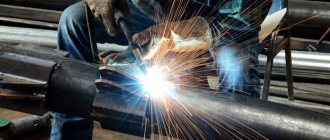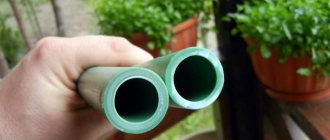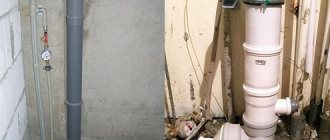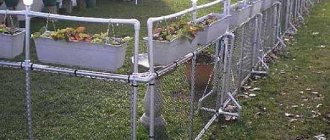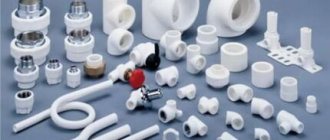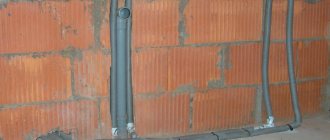How to create a greenhouse with your own hands? A properly planned and constructed mini-greenhouse will allow you to grow seedlings on time, create conditions for planting a future rich and healthy harvest, and there is no desire to spend a lot of money on buying a ready-made option, especially now when there is a crisis in the country. In this article we will tell you how to make a greenhouse from polypropylene pipes with your own hands, what materials you will need, and give step-by-step instructions.
Polypropylene pipes as a material for a greenhouse: features, advantages and disadvantages
A greenhouse made of polypropylene pipes is an excellent solution for garden owners. As a frame material they have the following advantages:
- synthetic material that is flexible, durable and highly environmentally friendly at the same time;
- the service life of the manufactured greenhouse will be on average 30-35 years;
- polypropylene structures are not exposed to moisture and can easily withstand any temperature conditions, which makes them a universal material for a greenhouse in any region of the country;
- low construction costs;
- due to their synthetic nature, the pipes are light in weight, which greatly simplifies delivery and installation work;
- affordable price;
- polypropylene has increased wear resistance compared to the same wooden structures.
Another advantage is the wide selection of pipes of various diameters from 20 mm to 1200 mm.
According to experts, the only disadvantages include the need to use a welding machine for installation work and additionally buy fitting connecting parts.
PVC pipes and methods of connecting them
PVC pipes are designed for installation of cold water supply systems and can be operated at temperatures up to +65 degrees. Thanks to the flexibility and wide variety of connecting elements, it is easy to assemble a greenhouse of any configuration from them.
For greenhouses, PVC pipes with a diameter of 20 to 32 mm are used; they provide the necessary rigidity of the frame. Standard pipe lengths can be 1, 2, 3 or 6 meters.
PVC pipes
There are several ways to connect PVC pipes for a greenhouse:
- using clamps, ties;
- on furniture bolts using pre-drilled holes;
- on glue.
When connecting pipes with clamps or bolts, the greenhouse can be completely disassembled and moved to another location, ensuring crop rotation. Film greenhouses and greenhouses are often installed this way. The film is usually removed for the winter to avoid damage by snow and wind, and the frame is dismantled at the same time.
One of the ways to attach PVC pipes
The adhesive connection is permanent, but more durable. It is recommended to be used for greenhouses installed on a foundation and left for the winter. Such greenhouses are usually covered with polycarbonate - it lasts at least 5-7 years and does not require annual replacement.
Connecting elements for PVC pipes used during greenhouse installation:
- corners allow for fastening mutually perpendicular elements;
- tees - connect three pipes in one plane or at an angle (single-plane tees can have an angle of 45, 66 and 90 degrees);
- crosspieces , for connecting four pipe elements.
Fittings for PVC pipes
The number and type of fittings used depend on the design of the greenhouse, as well as the type of connections chosen.
Prices for PVC pipes
pvc pipes
The procedure for connecting pipes and fittings with glue
The connection is made using Tangit PVC-U glue or its equivalent. This glue provides strong fastening of parts and hardens quickly, so installation will not take much time.
Tangit PVC Kleber
Prices for Tangit PVC Kleber
Tangit PVC Kleber
Sequencing.
- Cut the pipe to the required length using a cutter, hacksaw or construction scissors. Check the compatibility of the pipe and fitting: the pipe should fit into it 2/3 of the length of the socket.
- Clean the edges from burrs and use a knife to chamfer the end.
- Degrease the surfaces to be joined with any solvent. Apply glue to both surfaces to be glued: the pipe and the inner surface of the fitting.
- Insert the pipe into the fitting strictly along its axis to 2/3 of the depth until it stops, then turn 90 degrees inside the fitting so that the glue is evenly distributed.
- Fix them in this position for 15-30 seconds, then wait another 1-2 minutes until complete gluing.
Procedure for gluing pipes
The procedure for connecting pipes with bolts
Furniture bolts with a diameter of M6 or M8 are chosen as fasteners, depending on the diameter of the pipes. The length must be sufficient to connect two pipes.
Furniture tie bolt
Sequencing.
- Before installation, places in the pipes are marked for drilling holes.
- Drill through holes with a drill 2 mm larger than the diameter of the bolts.
- Connect the pipes by matching the holes. Insert and tighten the bolts.
Diagram of drilling holes using a simple wooden jig
Holes can also be drilled in place, with the pipe temporarily secured to a wire tie or secured in another way.
Types of greenhouse designs made of polypropylene pipes
Polypropylene pipes have received well-deserved recognition among gardeners due to their flexibility, strength and relatively low cost.
Before building a mini-greenhouse, you need to choose the type of structure. Let's consider the most popular types of structures made of polypropylene pipes.
Arched
The simplest is a ground greenhouse. Even a woman can cope with its bookmark. To arrange the arrangement, choose a place for future seedlings, prepare a bed and place polypropylene pipes at the same distance from each other, bending them in the form of arches.
Cover the structure from above with either film or agro-fabric, sprinkling the edges of the covering material with the same soil. Such a greenhouse is periodically opened, ventilated and all necessary work is carried out.
Box type
In second place in terms of ease of installation and assembly is the film “box”. This greenhouse is suitable for beginner gardeners. To arrange it, you do not need to make complex drawings and spend a lot of effort.
Thanks to the square shape of this design, so many seedlings can be grown on 1 sq.m of land that the quantity will be enough to plant 200 sq.m of land in the future. The disadvantages of this type, experts include poor lighting inside and rapid depletion of the soil.
"Breadbox"
The most optimal type of structure for obtaining a good and rich harvest is a “bread box”. The advantage of this greenhouse is that it can be made portable, seedlings can be sown in it immediately after the snow melts, without waiting for warm weather, and not only seedlings can be grown, but also larger crops. The “breadbox” can also be installed on the ground, or a wooden or other frame can be made under it. It is easy to open, ventilate, and care for.
"Butterfly"
The most difficult in terms of installation work is the “butterfly” greenhouse. This greenhouse has “wings” that are opened in warm weather for better lighting and rapid growth of seedlings. It can also be portable or installed directly on the ground, and will last for more than one season.
Gable
The design of the house is familiar to everyone, which can be absolutely any size convenient for you, and also have opening doors and sashes.
Wall-mounted
The most economical greenhouse option. It is ideal for small areas where there is no space to build a full structure. It can be built against the wall of a barn, a house, or even against a fence, the main thing is to choose a fairly bright place.
Sphere
The most difficult type. Greenhouses, as a rule, are not made like this. Here it comes to greenhouses. Making such a greenhouse is not easy, since the design requires special calculations where there is no room for error. But the sphere will become a worthy decoration of the site.
Useful tips and tricks
Before installing the frame, you should carefully study the diagram in order to assemble the structure as accurately as possible.
The site must be prepared. Earth should be added to the depressions and hills should be cut off.
The level should be checked at each stage.
Before lining the greenhouse with polycarbonate, it should be kept in a dry room for a day.
Polycarbonate sheets are laid with a protective film on the outside. It is removed upon completion of installation work.
How to choose a location for a greenhouse
When choosing a place to build a greenhouse, you need to give yourself answers to a number of questions
- Which place has the most light?
- Where should you expect strong gusts of wind?
- What kind of soil is on the site?
- Are there plans for additional communications to the greenhouse?
After analyzing the answers, it will become very clear to you which place on the site will be ideal for the future greenhouse.
Please note that experts recommend placing the greenhouse from east to west; it is in such beds that plants will have enough light for normal growth and development.
Diagram of the most favorable location of the greenhouse relative to the cardinal directions
Where to place the greenhouse on the site
In order for the plant to grow well, it is not enough to make a greenhouse; it must be correctly positioned on the site. There should not be a tall building or large trees blocking the light nearby.
In addition, during heavy rain or heavy watering, water should not accumulate, as this will negatively affect the growth of plants. If the place is low, then you need to make a platform or some kind of elevation. The easiest way is to half-dig the logs onto which the frame itself is already mounted.
Exposure to a large amount of sun will not harm the plant, since the structure can be covered with a special mesh for shading.
Selection of polypropylene pipes for a greenhouse
The choice of pipes directly depends on what specific design you choose. For arched greenhouses, it is better to choose pipes with a length of at least two meters and a diameter of 16 to 32 mm. For support posts of rectangular greenhouses, it is better to take more reliable ones with a diameter of 50 mm.
Important! If you plan to cover the greenhouse with film, and your area is not exposed to strong winds, then 16 mm in diameter is quite enough. If you decide to use polycarbonate, then you need to buy pipes with a diameter of at least 50 mm.
Calculation of the required amount of material
Even such a simple design as a greenhouse requires precise calculations. The main materials for this structure will be polypropylene pipes, as well as polyethylene film or cellular polycarbonate plates. Today on the Internet there are many online calculators with which you can easily, quickly, but not entirely accurately calculate the required configurations of figures and volumes of material. However, if you want to get exact dimensions, and therefore not spend extra money, you can carry out simple calculations yourself. All you need to do is remember one of the geometry lessons from the 7th grade textbook or use the instructions below. The most important thing in this situation will be to determine the exact number of pipes needed to create the arcs of the arched structure.
To do this, we will need the Pythagorean theorem and Huygens’ formula for calculating the length of the arc:
- From previously prepared drawings and diagrams we take the future width of the structure and its height. This is enough to make the necessary calculations. The diagram below shows an arc in which two right triangles are placed. In them we do not know the meaning of the hypotenuse - the side indicated by the letter m. To determine it, we apply the Pythagorean theorem. It looks like this: m = √b²+a²=√220²+150²=√70900=266.27.
The length of the greenhouse arc is calculated using simple formulas from a school textbook - Now let's use Huygens' formula, which looks like this: L≈2∙m+(2∙mM)/3. Substituting the values, we get the exact length of one arc required for our design: L≈2∙266.27+(2∙266.27–300)/3 = 532.54+(532.54–300)/3 = 532, 54+232.54/3 = 532.54+77.51=610.05 cm.
- Find the total length of the polypropylene pipes of all arcs in the structure. To do this, you need to multiply the length of one arc by their number in the frame. In total we will have 6 arcs every 90 cm. Substitute the values: 610.05∙6=3,660.3 cm.
- To the obtained value we add the length of the transverse tubes to strengthen the frame. Since the greenhouse has a length of 600 cm, and three pipes are needed, an additional 600∙3=1800 cm of pipe will be required. Then the total amount of polypropylene will be equal to 1,800 + 3,660.3 = 5,460.3 cm.
- We determine the area of polycarbonate sheets to cover the entire structure. We multiply the length of the arc by the length of the structure: 610.05∙600=366,030 cm2=36.6 m2. In the retail network you can buy standard polycarbonate sheets measuring 2.1 x 6 m (area 12.6 m2). Our greenhouse will require three such sheets.
Required Tools
To build an arched greenhouse structure made of polypropylene pipes, you cannot do without using the following tools:
- Bayonet and shovel.
- Hacksaws or grinders.
- File.
- A sharp knife.
- Blowtorch.
- Electric drill.
- Screwdriver.
- Hammer or sledgehammer.
Choosing a covering material for a greenhouse made of polypropylene pipes
We have decided on the pipes, but we will still focus on those whose diameter is 25 mm; they, in principle, are universal. There will be enough of them to build a fairly strong greenhouse. We suggest moving on to choosing a covering material. There are several types of it:
- Glass is a very heavy material that is not suitable for a greenhouse made of plastic pipes. Yes, it is often used in greenhouses, but polypropylene will not withstand it, especially since we are talking about a small structure - a greenhouse. In addition, glass is a very fragile and impractical coating.
- Polycarbonate is the most popular material today. It is easy to install, lightweight and protected from UV rays, retains heat well and transmits light. But it is suitable for a greenhouse only if the design provides for ventilation, otherwise the plants will be too hot there.
- Polyethylene film is the most affordable material. It requires virtually no installation effort; just throw it on and secure the ends with something heavy on the sides of the structure. The only drawback is the fragility of the material, which, even with good care, is unlikely to last you a season. There is also reinforced film, it will last much longer, but its price is quite higher.
- Spunbond is fabric, it is easy to find in specialized stores. It has excellent characteristics for the conductivity of heat, light, oxygen, moisture and will be an ideal coating for your greenhouse, however, good spunbond is not cheap.
Some gardeners also use agrofibre, but do not confuse it with a covering material; the most it can do is protect seedlings during their adaptation.
Video description
Another option on how to make a greenhouse from plastic pipes and polycarbonate with your own hands using bolted connections is shown in the video:
It is important! The top film from the polycarbonate is not removed until installation is complete. It protects the protective layer applied to the sheet from damage from ultraviolet rays, which destroy both the material itself and polypropylene pipes.
But sealed connections are more reliable; in addition, if you drill holes in the pipes of the frame assembled in this way and connect it to a pressure water supply, you can simplify watering the greenhouse.
Mobile greenhouses
To be able to move the greenhouse from place to place, all frame elements must be connected to each other. Therefore, instead of a foundation, the racks are attached to a rectangular base of the same pipes by welding or gluing using fittings.
Portable greenhouse frame Source homeli.ru
Schemes and drawings of a greenhouse made of polypropylene pipes
After you decide on the design of the required greenhouse, you need to prepare calculations and drawings for construction and purchasing consumables.
For any design, it is better to choose a well-lit area with the least airflow. Then you need to determine the area of the greenhouse and the types of crops that will be grown in it.
The optimal sizes are usually:
- width – 3 meters;
- length – from 4 to 6 meters;
- height – 2-2.5 meters.
Example drawings
Arched greenhouse 1.5 by 4 m
If a ground greenhouse is planned, then the recommended height is 80 cm and the width is 1.5 m. The distance between the posts should not exceed 1 m.
It is not recommended to build a mini-greenhouse more than 2-2.5 meters high. Due to the high altitude, the greenhouse effect is lost and the thermal insulation properties of the structure are reduced.
Drawing of an arched greenhouse
To improve the quality of lighting and ventilation for growing seedlings in large greenhouses, windows and doors are installed on each end side.
Profile drawing of a small arched greenhouse with door
When constructing metal-plastic frame models, many use reinforcing bars, which are installed around the perimeter every 45-50 cm, deepening them into the ground by 60-70 cm, which will give the structure stability when the wind increases.
What materials and tools are needed
To make a standard greenhouse, you need to prepare the following materials:
- five-meter boards with a section of 2x6 cm - 4 pieces;
- boards with a section of 2x6 cm, length 3.7 m - 2 pieces;
- PVC pipes 6 m long—19 pieces;
- fittings 3 meters long (Ø10 mm) – 9 pieces;
- PVC film (thickness 6 mm) – 6x15.24 meters;
- wooden slats (length 1.22 m) - 50 pieces;
- nails or screws;
- metal fastenings;
- door hinges - 4 pieces;
- door handles - 2 pieces.
Materials for the ends of the greenhouse:
- timber 2x4 cm 3.7 m long for the frame;
- 11'8 3/4” - 2 beams 3.6 m long;
- 1'6” - 4 bars of 0.45 m each;
- 4'7” - 4 bars of 1.4 m each;
- 5'7” - 4 bars of 1.7 m each;
- 1'11 1/4” - 8 bars of 0.6 m each;
- 4'1/4” - 2 bars of 1.23 m each;
- 4 bars 1.5 m long;
- 4 bars 1.2 m long.
Required tools:
- hammer;
- Bulgarian;
- electric screwdriver;
- hacksaw for metal;
- electric saw;
- building level;
- roulette.
Brief instructions for building a greenhouse from polypropylene pipes
Let's look step by step at how to build a greenhouse from plastic pipes with your own hands.
First, prepare and level the place for the foundation:
- install pegs and stretch a rope between them;
- the slope is determined by level and, if necessary, re-leveling is carried out;
- pour a “cushion” for the foundation made of sand with a height of 5 to 10 cm.
Depending on the size of the future greenhouse, consumables are prepared:
- boards – 4 pcs. in length and 6 pcs. in width;
- pipes - with a diameter of 20 mm (3-4 pcs.) and 25 mm (9-10 pcs.);
- reinforcing pins – 18-25 pcs.;
- latch holders – 25-30 pcs.;
- wood screws No. 50 – 36-40 pcs;
- film, either agrofabric or polycarbonate;
- screwdriver;
- hammer;
- sledgehammer
After the greenhouse area is leveled and marked:
- boards or timber for the foundation are impregnated on site with an antiseptic;
- dry; install them according to marks on a sand cushion and fasten them together; along the outside of the boards every 45-50 cm
- install latches for fittings;
- insert reinforcing pins into the holders, deepening them 40 cm into the ground and snap them into place.
When the foundation of the boards is ready, the installation of the frame begins. A 25 mm pipe is inserted into the first pair of reinforcing pins in an arcuate manner and secured with holders.
Do the same with all other arcs. Then a cross section is assembled from 20 mm sections, connecting them to the arches using latches or special clips. (further we will talk in more detail about the production of such a greenhouse)
After installing the frame, any material chosen for the greenhouse is fixed on top of it: film, spunbond, polycarbonate. The optimal choice, of course, is polycarbonate, since it perfectly transmits light inside to the plants and lasts 5 years, while the film cover must be dismantled every year. If the greenhouse is sheathed with polycarbonate sheets, thermal washers must be purchased to secure them.
Some gardeners have no less success installing special supports for growing cucumbers made of polypropylene.
These trellises allow plants to grow upward rather than spread out over the beds, making harvesting much easier. In a similar way, you can build a greenhouse from PVC pipes with your own hands.
Types of greenhouses
The classification of greenhouses is quite complex: they can vary in shape, seasonality, presence and type of heating, frame and cover material used.
Variety of greenhouse designs made of plastic pipes
The simplest and most reliable designs are suitable for manufacturing from PVC pipes, including:
- wall greenhouse;
- gable , in the form of a house;
- polygonal , with a complex shape of slopes;
- arched , with a frame in the shape of a semicircle.
Types of greenhouses
Wall-mounted greenhouses are usually attached to the southern or southwestern wall of a house or other room. In this case, the wall plays the role of thermal mass: heating up during the day, it gives off heat at night, which reduces average daily temperature fluctuations and also protects from cold northern winds.
Wall greenhouse
In wall-mounted greenhouses, a microclimate favorable for plants is created, and the cost is lower than that of free-standing models. The main disadvantage of this design is the constant exposure of the wall to moisture and the lack of good ventilation, which can lead to destruction of the wall material.
The gable design is one of the most convenient and popular. This is explained by the strength of the frame and its resistance to snow and wind loads. The reflection coefficient of gable greenhouses is low, most of the sun's rays penetrate inside, which increases the lighting efficiency. By increasing the angle of the slopes, you can achieve snow melting in winter, and the greenhouse will not have to be raked.
Gable greenhouse
Gable greenhouses are equipped with one or two doors, as well as vents for ventilation. The side walls of gable greenhouses can be either strictly vertical or inclined. In the second case, the illumination in the greenhouse in the morning and evening hours will be higher, which is important for temperate latitudes.
The polygonal design of the greenhouse practically follows the shape of the arch due to several planes forming slopes and walls. Thanks to this, the internal space is increased and at the same time the main disadvantage of arched greenhouses is compensated for - the high coefficient of reflection of solar rays.
Polygonal greenhouse
It is difficult to assemble a polygonal greenhouse from pipes with your own hands due to the large number of connecting nodes, so it is usually made from metal pipes by welding or from a profile for plasterboard, assembling the frame with self-tapping screws.
An arched greenhouse is perhaps one of the most common designs, and this is easily explained: it is distinguished by strength and stability, a minimum number of connecting nodes and a large internal space. It can be made from almost any type of pipe, choosing any size and height.
Arched greenhouse
The disadvantages of arched greenhouses include increased accumulation of snow on the roof in winter and a high reflection coefficient from the inclined plane of the film or polycarbonate.
Partial reflection is compensated by correct installation of the greenhouse - from north to south. With this arrangement, the side walls are illuminated by the morning and evening sun, and the rays hit the walls of the greenhouse almost at a right angle. During the day, when the sun is high, it illuminates the southern gable and roof, where the refraction of rays is not so strong.
Snow accumulation is dealt with in three ways:
- regular cleaning;
- dismantling the film or the entire greenhouse for the winter;
- changing the shape to a pointed arch.
Lancet greenhouse
Greenhouses in the shape of a pointed arch have a more stable design, and their increased height has a beneficial effect on the microclimate: hot superheated air accumulates at the top and does not depress the plants. At the same time, material consumption and planting area do not differ from similar indicators for conventional arched greenhouses.
Detailed step-by-step instructions for building a greenhouse from polypropylene pipes
Step 1. Draw a drawing
Any construction must begin with the creation of a drawing. Otherwise, the structure may collapse, and the amount of materials may be less or, conversely, more than required. When drawing up a drawing, you need to consider the following points:
- what will serve as the basis;
- what size and shape will the greenhouse be;
- what covering material will be used;
- how the pipe elements will be connected to each other;
- what additional partitions are planned inside.
This way you can understand how many meters of pipes you need, how many screws or clamps you need to purchase, how many boards to prepare for the base, how much film or polycarbonate you will need.
Experts recommend planning beds with a width of 0.8 to 1 meter; this is what is considered optimal for a gardener’s comfortable work. The width of the path should be approximately 70 cm.
Step 2. Calculate the amount of materials
If you are planning to build an arched greenhouse, we offer you a universal material calculation system:
- We determine the width we need (C=b+b) and the height of the structure (a).
- We calculate the distance m (the root of the sum of the squares of a and b, remember the Pythagorean theorem).
- We calculate the arc length using the formula 2*m+(2*m+M)/3, where M is the total width of the greenhouse from arc to arc.
- The resulting number is equal to the length of one arc, multiply it by the number of arcs and get the total length of polypropylene pipes.
- We determine the amount of covering material and calculate its area by multiplying the length of the greenhouse by the length of the arc.
The most necessary calculations have been made, now you can easily determine how many meters of arcs and film you need to purchase. If you plan to dig arcs into the ground, then feel free to add another 20 centimeters to the length of each one (just do not take them into account when calculating the size of the covering material).
Step 3. Prepare tools and materials
We offer you step-by-step instructions for making a greenhouse measuring 3.9 × 2 m with a height of 1.5 m. For this you will need:
- 10 wooden boards treated with an agent against rot and pests: 4 pcs. 5 m long and 6 pcs. 70 cm long.
- 12 polypropylene pipes 4 m long: 9 pcs. with a diameter of 25 mm and 3 pcs. with a diameter of 20 mm.
- 18 pieces of reinforcement 65 cm long.
- 25 fastenings for polypropylene pipes.
- Self-tapping screws for assembling a wooden frame.
You don't need any specialized tools; a large hammer and screwdriver will be enough.
Step 4. Making a foundation or base for a greenhouse
A serious foundation is needed only for greenhouses made of polypropylene pipes. Here's how it's done:
- The site where the structure will stand is leveled in advance.
Selecting part of the site
- Dig a trench, the depth of which depends on the proximity of groundwater. The soil inside the trench is properly compacted.
- Formwork is made from wooden planks.
- Pour the solution inside and prepare the holes where the pipes will be attached.
But building a greenhouse is much easier. Again, because it does not require a reliable foundation, it is quite enough to dig in the reinforcement at a certain distance from each other.
If you want to make the structure more reliable and solid (as in our case), then we suggest making a wooden base.
You should take pre-prepared boards and use self-tapping screws to build two rectangles from them, attaching a transverse strip from a short board in the middle. You will get two wooden frames for future beds; we recommend making the paths between them 50 cm wide.
Frame for future beds
It is logical to assume that this structure will not be capital unless it is further strengthened. For this, you will need reinforcement, which is driven into the ground with a hammer approximately 30-40 cm along the entire outer perimeter of the wooden base and attached to it using special rivets closer to the ground.
Reinforced frame
If it is not possible to use reinforcement, then you can take 4 pieces of metal pipe, drive them into each of the four corners around the perimeter, and connect them together using a metal strip tie.
Step 5. Assembling a frame from pipes: photo instructions
| Illustration | Description of action |
| It remains to connect the pre-cut arcs into the greenhouse frame. This is done simply - pipes are inserted into the prepared fittings, installed in accordance with a predetermined distance between the arcs, which take the shape of the arc. | |
| Each arc is attached to the frame using special fasteners. | |
| We do the same with all the other pipes. | |
| The remaining three pipes will serve as ties for the frame. They are attached to the sides and top of the structure using special pipe latches. | |
| This is what a greenhouse looks like. |
Step 6. Laying covering material
The easiest way is to cover the greenhouse with film or spunbond.
These materials are attached to the arches using special plastic holders.
The material can be attached to the wooden base of the greenhouse with self-tapping screws on one side for reliability, but we recommend simply pressing the other side to the ground with something heavy if you plan to periodically open the greenhouse for ventilation. The end sides can be made blank, or you can also press the ends to the ground and periodically fold them back.
If you took very dense and powerful pipes in advance, you can screw polycarbonate to them. Here are some tips for installing it:
- For installation, use self-tapping screws with a thermal washer to avoid damaging the canvas.
- The polycarbonate should protrude about 5 cm above the ends.
- The sheets are stacked on top of each other with an overlap of 10 cm.
- When working with polycarbonate, a sharp knife is used.
The polycarbonate sheet is adjusted to the shape of the end using a well-sharpened stationery knife
Types of structures
When choosing a model and size, you need to know exactly its purpose. If you plan to grow vegetables only for yourself, then a size of 0.5 meters wide, 1.5 meters long and 1.3 meters high is sufficient (this is the standard height of greenhouses).
By type, greenhouses are divided into:
- Arched is the simplest and most inexpensive option for assembly. Its streamlined shape resists wind and rain well. This model of greenhouse is often made from polypropylene pipes by gardeners; the sizes can vary. Usually covered with film.
- A mini-greenhouse made of polypropylene pipes is a common home-made option among summer residents and comes in different shapes:
- In the form of a simple square frame covered with film. It is used more often for germinating seedlings. This model can be bulk or ground, since after 3 months the soil is depleted. Another minus is the lack of light. But on 1 m2 you can grow seedlings for 20 acres of land.
- “Butterfly” is a model for crops that require constant air. It is built like an arch and has opening doors on the sides, which is very convenient. Excellent option for peppers, tomatoes and cucumbers.
- “Breadbox” - suitable for gardeners with little experience. It is inexpensive and the installation process is simple. The “bread box” made of polypropylene pipes is intended for low-growing crops; it is a box with an opening lid.
- Rectangular - consists of walls and a roof, which can be single-pitched or gable. Also often found in areas.
- Shed - a structure of three walls with a covering on top. The roof has a steep slope. Typically used for growing radishes and carrots.
- Gable - a classic option, from the middle of the roof the slopes diverge in both directions.
- Combined - with several sections, not very popular for construction on a small plot with your own hands.
- Wall-mounted is an excellent solution for a small area. Saves both space and material. In addition, this structure is stable and durable, as it rests on the wall of the house. But it is suitable only when the house does not create shading on the greenhouse.
Almost all types of greenhouses made of polypropylene pipes can be made either permanent or collapsible.
However, the collapsible design is more convenient and mobile; it can be removed for the winter, or, if necessary, moved to another area. In general, polypropylene pipes, in addition to plumbing purposes, can also be used for the construction of greenhouses and greenhouses.
Greenhouse-house: a method of self-production from polypropylene pipes
A greenhouse-house will look harmonious on any site; the gable structure will allow snow to roll freely in winter, and such a roof will correctly distribute the light inside due to its refraction.
Polypropylene pipes are easily fastened together with fittings
When planning the design of such a greenhouse, consider a ventilation system: either the roof will open, or there will be a door and a window at the ends. The side walls can be placed at right angles to the surface of the earth, or they can be made slightly inclined inward, which will increase the area for light penetration.
In addition to pipes, you will need fittings to connect them, as well as a special soldering tool, which can be rented at almost any hardware store for a not very large fee.
Do you need a foundation?
The greenhouse can be installed either on a foundation or without it.
Advantages of permanent structures on a permanent foundation:
- high strength and stability;
- lower heat loss, if you make thermal insulation and organize heating, you can use the greenhouse not only in the warm season, but also in winter;
- the base will last for many years, and the superstructure can be changed at your discretion.
Investing large amounts of money on foundation construction is not always advisable. Greenhouses are often used as a temporary shelter for plants from the cold or, for example, to create special conditions for rooting cuttings.
Pros of portable buildings:
- No foundation costs are required.
- Easily disassembled for the winter.
- The greenhouse can be rearranged every season, so the soil is less depleted. It does not need to be changed every 3 years, as in stationary structures.
It is important to secure the base well in the ground, otherwise during gusts of wind the structure will “walk” around the site.
